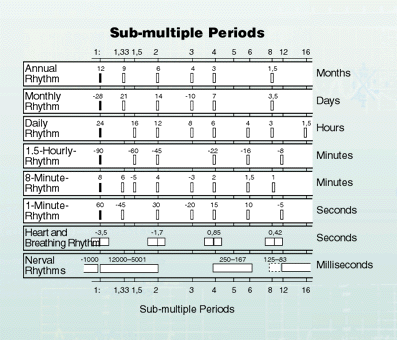In illustration 25 all observed reactive periods with the appropriate spontaneous rhythms have been compiled. The resting, completely balanced organism primarily utilizes the spontaneous basic rhythms which have been marked by the filled in thick lines in the left margin of the illustration. Each one of these basic rhythms presents the basis of a block, in which the reactive periods marked by open thick lines occur which preferably are in simple whole numbered harmonic ratios to the basic rhythm.
The more strain is put on an organism, the more reactive periods are formed which keep more complicated intervals. The individual blocks usually reach up to the frequency ratio of 1:8 compared to the basic rhythm (“Octave”-blocks?). This reminds one of well-known physical-chemical basic structures with harmonic qualities. In the high frequency area of the spectrum the proportions increasingly dissolve as a result of the frequency modulating influences which have already been shown.

